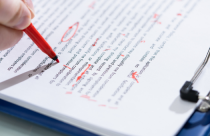Reject Your Own Manuscript! Why Self-Editing is Critical

Professor Wahoo of Big Science University was confident as he dropped his manuscript into the post. Writing the paper was the final act of a lengthy and difficult research project. He knew that it was an excellent study and one that would change the nature of his field. Although he had only written a single draft, he was not worried. Why should he worry? The peer reviewers would obviously see the importance of the work and accept it for publication. Unfortunately, what seemed obvious to the author was a complete mystery to the reviewers. Weeks later, Dr. Wahoo sat heavily in his chair with the rejected manuscript in his lap. He could not believe that his paper was rejected. So how did this happen?
Dr. Wahoo’s paper was rejected because he wrote only a single draft. While the science was impeccable, the writing was flawed. The reviewers could not understand the study, therefore, it was impossible to grasp its significance. Dr. Wahoo should have self-edited his manuscript.
What Does it Mean to Self-Edit a Paper?
Self-editing a manuscript is exactly what it sounds like. After writing an initial (first) draft, the author then corrects his/her own writing. Multiple drafts are produced until the manuscript is in the best shape possible. The paper must easily convey the author’s intentions to any reader. Submitting a self-edited and highly refined paper does three things:
1) It makes the reviewers/editors job easier
2) It allows the reviewers/editors to better assess the paper’s validity
3) It increases the chance of the paper getting accepted for publication
How to Self-Edit Your Paper
Once you have completed a manuscript, you must not hurry to submit it. Yes, it was hard writing it. However, you need to continue working on it. After all, your goal is to get the manuscript published? Any efforts lesser than this will only increase the probability of rejection. By following the below steps, you can improve your own manuscript and have it in the best possible shape for submission.
Print your Paper
Always print a hard copy of your manuscript. You need to see if what you have written is different from what you typed on the computer. This will refresh your eyes and help you become “detached” from your own work. Quickly read through the paper once. Then take your red pen and start marking it.
Take a Break
After you have completed the first draft, take a break of at least a few hours. A day or more is best. When you return to the paper, you will see it with a fresh opinion and be less likely to gloss over the text. It will be easier to spot mistakes and sentences with troubles. Don’t attempt to completely revise the paper in one sitting. Take frequent breaks. Keep refreshing yourself throughout the self-editing process. Give yourself several days or a week to complete the process of self-editing.
Read your Paper Out Loud
When you read your paper out loud it should sound smooth. If something does not make sense or you stumble over it, mark the section and move on. When finished with reading the paper, edit the marked errors and re-read.
Imagine You are the Reviewer
To effectively self-edit, you need to disengage yourself as the author. You need to assume the role of a person who has never read your paper before. Pretend you’re the reviewer and you’re not having a good day. This will put you in a critical state of mind to find every flaw possible needed to reject the work.
Be Brutal, Be Ruthless
The best editors are those that brutalize papers without mercy. Cast your ego aside and become your paper’s worst enemy. Use your red pen as a weapon and try some of the following:
- Don’t use adverbs and adjectives if possible – On your hard copy, mark out every adverb and adjective. Add them back only when they are necessary.
- Reduce each sentence to its essential parts – A sentence has a subject, verb, and object. Try to keep the sentences as simple as possible.
- Keep paragraphs short – Avoid redundancy: one sentence, one idea. If you have more than five sentences in a paragraph, examine it to see if it can be shortened.
- Avoid too many subordinate (dependent) clauses – Instead of writing, “When mice became stressed because of lack of sleep, we administered an antibiotic to prevent secondary infections.” Write this, “We administered an antibiotic to prevent secondary infections in sleep-deprived mice.”
- Be the authority. Don’t offer an opinion – Avoid sentences with “we believe”, “it appears”, or “seems to be”. Be strong and stand behind your writing. “The cause of resistant bacteria is the over-use of antibiotics.”
Read your Paper from Back to Front
You’ll be amazed at how many mistakes and problems you can find by reading your paper from back to front. This slows your brain down and keeps you from glossing over a familiar writing.
Don’t Rely on SpellCheck
Spellcheck is very useful and will find most misspellings. However, it won’t find words that are used inappropriately. “Their is a 25% probability that ants of afflicted children will show an affect.” So do not rely completely on Spellcheck.
There is much more to getting a publication than simply writing a manuscript and submitting it. The initial writing is the easiest part. The real work is to improve the paper so it clearly communicates what you want. This is done through self-editing. So once you are convinced with the self-edited manuscript, you can send it out to others for review.
Have you thought about using a professional editing service? Should native English speakers hire copy editors? Let us know your thoughts in the comments below!










